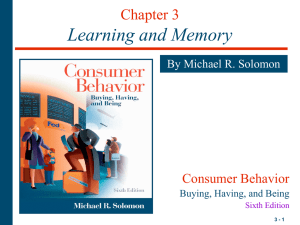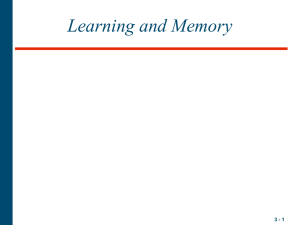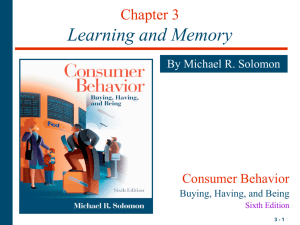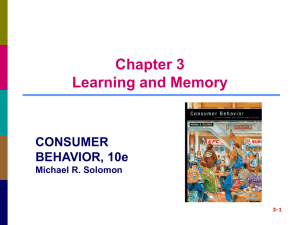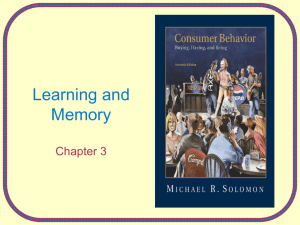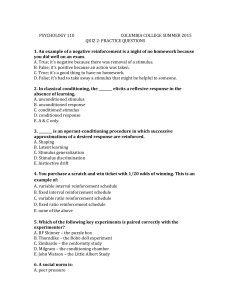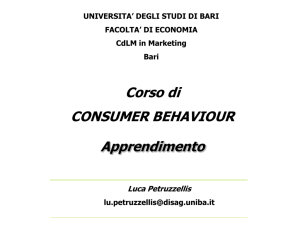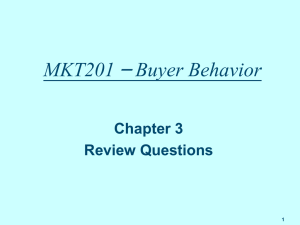Chapter 1 Consumers Rule
advertisement
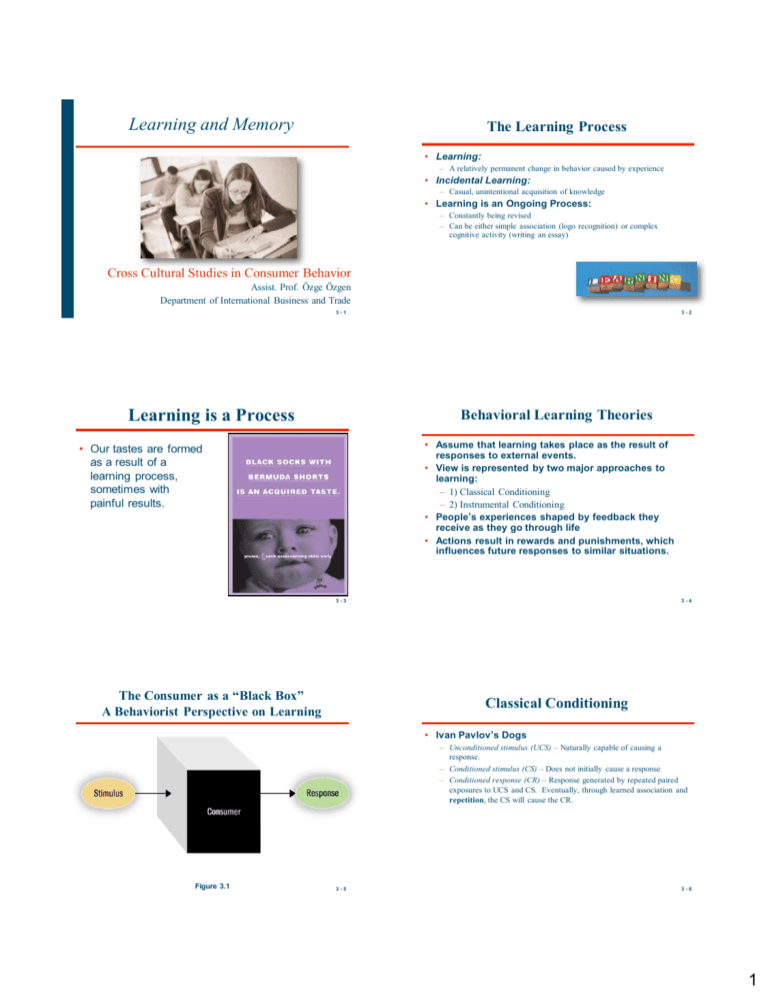
Learning and Memory The Learning Process • Learning: – A relatively permanent change in behavior caused by experience • Incidental Learning: – Casual, unintentional acquisition of knowledge • Learning is an Ongoing Process: – Constantly being revised – Can be either simple association (logo recognition) or complex cognitive activity (writing an essay) Cross Cultural Studies in Consumer Behavior Assist. Prof. Özge Özgen Department of International Business and Trade 3-1 Learning is a Process 3-2 Behavioral Learning Theories • Assume that learning takes place as the result of responses to external events. • View is represented by two major approaches to learning: – 1) Classical Conditioning – 2) Instrumental Conditioning • People’s experiences shaped by feedback they receive as they go through life • Actions result in rewards and punishments, which influences future responses to similar situations. • Our tastes are formed as a result of a learning process, sometimes with painful results. 3-3 The Consumer as a “Black Box” A Behaviorist Perspective on Learning 3-4 Classical Conditioning • Ivan Pavlov’s Dogs – Unconditioned stimulus (UCS) – Naturally capable of causing a response. – Conditioned stimulus (CS) – Does not initially cause a response – Conditioned response (CR) – Response generated by repeated paired exposures to UCS and CS. Eventually, through learned association and repetition, the CS will cause the CR. Figure 3.1 3-5 3-6 1 Fake vs. Original • In the 1980’s, the Lacoste crocodile was an exclusive logo symbolizing casual elegance. When it was repeated on baby clothes and other items, it lost its cache and began to be replaced by contenders such as the Ralph Lauren Polo Player. 3-7 Classical Conditioning in Advertising 3-8 Classical Conditioning in Advertising • This American Airlines ad points to classical conditioning as an explanation for why their Advantage Marketing Programs will work. • Can you identify the UCS, CS, and the CR in this example? 3-9 3 - 10 Marketing Applications of Behavior Learning Principles Classical Conditioning (cont.) • Stimulus generalization: • Brand Equity: – Tendency of a stimulus similar to a CS to evoke similar, conditioned responses – A brand has strong positive associations in a consumer’s memory and • Masked branding: commands loyalty. – Deliberately hiding a product’s true origin • Applications of Repetition • Stimulus discrimination: – Occurs when a UCS does not follow a stimulus similar to a CS. 3 - 11 3 - 12 2 Marketing Applications of Behavior Learning Principles (cont.) Loyalty to Brands • Rewarding consumers with frequent flyer miles is an effective way to reinforce them and build brand loyalty. • Applications of Stimulus Generalization: – – – – Family branding Product line extensions Licensing Look-alike packaging • Applications of Stimulus Discrimination: – Consumers learn to differentiate a brand from its competitors – Unique attributes of the brand 3 - 13 3 - 14 Applications of Stimulus Generalization Applications of Stimulus Generalization • • • • Turkish Wine Greek Wine Italian Wine French Wine 3 - 15 3 - 16 3 - 17 3 - 18 Applications of Stimulus Generalization 3 Instrumental Conditioning Instrumental Conditioning (cont.) Number – Positive reinforcement – Negative reinforcement – Punishment • Extinction: When a positive outcome is no longer received, the learned stimulus-response connection will not be maintained. • Reinforcement Schedules: Time • Occurs as the individual learns to perform behaviors that produce positive outcomes and avoid behaviors that yield negative outcomes • “Operant Conditioning” • Occurs one of three ways: – – – – Fixed-interval reinforcement Variable-interval reinforcement Fixed-ratio reinforcement Variable-ratio reinforcement After a specified time period has passed, the first response that is made brings the reward People don’t know the time of the reinforcement Reinforcement occurs only after a fixed number of responses. The person is reinforced after a certain number of responses, but he or she doesn’t know how many responses required. 3 - 20 3 - 19 Four Types of Learning Outcomes Figure 3.2 3 - 21 Negative Reinforcement 3 - 22 Applications of Instrumental Conditioning Principles • Reinforcement of Consumption: – Thank you – Rebates – Follow-up phone calls • Frequency Marketing: – Reinforces regular purchases by giving them rewards with values that increase along with the amount purchased • Frequent flyer miles 3 - 23 3 - 24 4 Positive Reinforcement Positive Reinforcement 3 - 25 3 - 26 Components of Observational Learning Cognitive Learning Theory • Is learning cognitive or not? – Trigger feature • A stimulus that cues an individual toward a particular pattern and activates a reaction • Observational learning: – Occurs when people watch the actions of others and note reinforcements received for their behaviors – Learning occurs as a result of vicarious, rather than direct, experience. 3 - 27 Figure 3.3 3 - 28 Applications of Cognitive Learning Principles • Consumers learn vicariously by seeing others receive reinforcement for their behaviors. • Marketers can reinforce or punish consumers indirectly by showing what happens to desirable models who do or do not use their products. • Consumers’ evaluations of models are not limited to stimulus-response connections. – Attractiveness can be based on several components (e.g. physical attractiveness, expertise, similarity to the evaluator) 3 - 29 3 - 30 5 The Memory Process The Role of Memory in Learning • Memory – A process of acquiring and storing information such that it will be available when needed. • Stages of Memory – Encoding stage • Information entered in a recognizable way – Storage stage • Knowledge integrated into what is already there and warehoused – Retrieval stage • The person accesses the desired information Figure 3.4 3 - 31 3 - 32 Encoding Information for Later Retrieval Memory and Advertising • Types of meaning: – Sensory meaning (e.g. color or shape) – Sense of familiarity (e.g. seeing a food that we have tasted) – Semantic meaning: Symbolic associations (e.g. rich people drink champagne) • Personal relevance: – Episodic memories: Relate to events that are personally relevant – Flashbulb memories: Especially vivid associations – Narrative: An effective way of persuading people to construct a mental representation of the information that they are viewing This Brazilian ad illustrates that external memory aids like Post-Its can help us to remember many of the details of modern life. 3 - 33 Logos and Sensory Meanings 3 - 34 Logos and Meanings • HSBC LOGO • ING LOGO • OPEL LOGO 3 - 35 3 - 36 6 Memory Systems Storing Information in Memory (cont.) • Sensory Memory: – Very temporary storage of information we receive from our senses • Short-Term Memory (STM): – Limited period of time & limited capacity – Working memory (i.e., holds memory we are currently processing) • Long-Term Memory (LTM): – Can retain information for a long period of time – Elaboration rehearsal is required: Process involves thinking about a stimulus and relating it to information already in memory • Associative Networks: – Contains many bits of related information organized according to some set of relationships – Knowledge structures: Complex “spider webs” filled with pieces of data – Hierarchical processing model: Message is processed in a bottom-up fashion (i.e., starts at a basic level and is subject to increasingly complex processing which requires increased cognitive capacity) – Node: A concept related to a category – An associative network is developed as links form between nodes. 3 - 37 3 - 38 Retrieving Information for Purchase Decisions An Associative Network for Perfumes • Factors Influencing Retrieval: – Physiological Factors (e.g. age) – Situational Factors: • Pioneering brand: First brand to enter a market. Is generally easier to retrieve from memory. • Descriptive brand names easier to recall than names that do no provide cues to what the product is. – Viewing environment: Commercials shown first in a series of ads are recalled better than those shown last. – Postexperience advertising effects: • When consumers confuse recently viewed ads with their own experiences. Figure 3.6 3 - 39 Retrieving Information for Purchase Decisions (cont.) 3 - 40 Pictorial versus Verbal Cues • State-Dependent Retrieval: – (a.k.a. mood congruence effect) A process by which consumers are better able to access info if their mood is the same at the time of their recall as when the info was learned. – A few marketing researchers use hypnosis to dredge up past memories of experiences with products. • Familiarity and Recall: – Prior familiarity enhances recall. • Salience and Recall: – Salience: The prominence or level of activation of stimuli in memory – Von Restorff Effect: Any technique that increases the novelty of a stimulus also improves recall. 3 - 41 • There is some evidence for the superiority of visual memory over verbal memory. • Pictorial ads may enhance recall, but do not necessarily improve comprehension. • How many of these Ad icons can you remember from the picture alone? 3 - 42 7 Factors Influencing Forgetting Products as Memory Markers • Decay: – Structural changes in the brain produced by learning simply go away. • Retroactive Interference: – Consumers forget stimulus-response associations when new responses to the same or similar stimuli are learned. • Proactive Interference: • Products and ads can serve as powerful retrieval cues. – Autobiographical memories: Consumer memories related to their own past. – Mnemonic qualities: Aspects of a consumer’s possessions that serve as a form of external memory which prompts the retrieval of episodic memories. • The Marketing Power of Nostalgia – As new responses are learned, a stimulus loses its effectiveness in retrieving the old response. – Spontaneous recovery: The ability of a stimulus to evoke a response years after it is initially perceived. • Part-list Cueing Effect: – When only a portion of the items in a category are presented to consumers, the omitted items are not as easily recalled. • Memory and Aesthetic Preferences – Ads and products that remind consumers of their past also help to determine what they like now. 3 - 43 Nostalgia Appeal 3 - 44 Discussion Question Fossil’s product designs evoke memories of earlier classic designs 3 - 45 • Ads with celebrities like Britney Spears tend to have very high recall rates. • Name some ads with celebrities that you can recall easily. Why does the celebrity association with the ad aid your recall? 3 - 46 Problems with Memory Measures • Response Biases – A contaminated result due to the instrument or the respondent, rather than the object that is being measured. • Memory Lapses – Unintentionally forgetting information: • Omitting: Leaving facts out • Averaging: “Normalizing” memories by not reporting extreme cases • Telescoping: Inaccurate recall of time • Memory for Facts Versus Feelings – Recall is important but not sufficient to alter consumer preferences – More sophisticated attitude-changing strategies are needed. 3 - 47 8
